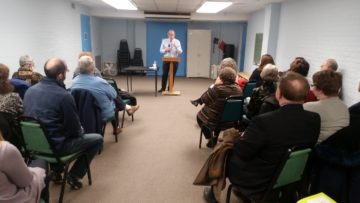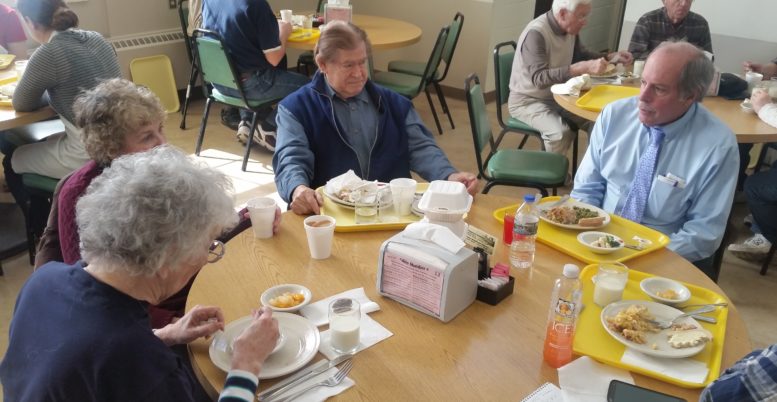By JAN LARSON McLAUGHLIN
BG Independent News
It’s more than the meatloaf and lemon meringue pie that draws senior citizens to congregate meals at community centers across the nation. It’s something that doesn’t show up on the daily menu. And it’s something that many seniors can’t get their daily dosage of at home.
Almost as important as the nutrition served up at senior centers is the conversation shared around the dinner tables.
Robert Blancato, executive director of the National Association of Nutrition and Aging Services Programs, is going across the nation doing research on the value of congregate meals for senior citizens. On Friday, he was in Bowling Green at the Wood County Senior Center for lunch with local citizens.
“We know there’s a growing problem of isolation of older people,” Blancato said. So he is surveying seniors about the values of casseroles and conversations. “I’ve decided to sit with older adults and ask them myself.”
Denise Niese, executive director of the Wood County Committee on Aging, said much research has been done on how home-delivered meals help seniors remain independent in their own homes.
“We know the value of home-delivered meals,” Niese said. But until now, no one has surveyed the value of congregate meals.
As Blancato chats with seniors over chicken or lasagna, he finds a common thread in the conversation. “They use the word socialization,” he said. They talk about the opportunity to get out of the house, to volunteer, and to learn from others.
On Thursday, Blancato sat down for a meal in East Cleveland and heard the same comments. “They’ve been verification of the importance of these programs.”
His favorite comment came from an older woman at a center in Fort Wayne, Indiana. “Because we love to gossip,” she told him.
“Every time I talk to older adults, they provide the proof,” Blancato said.
However, while Blancato is gathering up research supporting the value of congregate dining programs, the federal government is threatening massive funding cuts.
The Older Americans Act has already been lagging in funding for years, he said. “It is nowhere near enough to meet the needs.”
But Blancato pointed out that the average age of seniors showing up for congregate meals is in the upper 70s, and the average age for those getting home-delivered meals is the lower 80s. The lack of the nutrition provided by those meals would result in far more people living in nursing home facilities.
“Look how much this is saving Medicare and Medicaid,” he said.
But the future of funding for such senior programs is unknown since Congress doesn’t have it budget ready. President Donald Trump announced this week during his speech to Congress that he plans significant increases in spending for defense and law enforcement.
That means cuts elsewhere. “It’s a scary number for anybody in this room,” Blancato said of the proposed $54 billion cut to other programs. One answer could be a 10 percent across the board cut to other programs.
However, some in Congress have been around long enough to remember the 2013 sequestration, when many budgets suffered a 5 percent cut. When member of Congress went home to their districts, they heard “horror stories” of the effects of the budget cuts, he said.
But so much is a mystery right now, Blancato said.
“A leak is not legislative language,” he said. “There are so many unknowns, you can’t believe what’s going on in Washington.”

Bob Blancato talks with local service providers about proposed federal budget cuts.
So Blancato told service providers in Wood County to start collecting information and personal stories.
“We’re going to have to get ready to defend our programs,” he said, “in this new world.”
First, are the services provided something only the government can do? Second, is money being saved by spending money to provide nutritious meals? And third, are their jobs at stake? “We have to get in that conversation,” he said.
Wood County Health Commissioner Ben Batey, who also serves on the county committee on aging board, asked if local agencies should be planning for that 10 percent budget cut. The health district’s strategic planning would “go out the window” if that happens.
“I personally don’t believe a cut of that magnitude will happen,” Blancato said. However, some agencies such as the National Endowment of the Arts may be eliminated, he said.
Blancato suggested that local service providers stay in contact with their legislators.
“Don’t hit the panic button yet,” he said. “But it’s never too early to plan” for potential cuts.
And collect personal stories about people impacted. “The individual stories end up being far more important than the data,” Blancato said.
Blancato also talked about other issues being faced by those providing congregate meals for senior citizens. Transportation continues to be a roadblock for some seniors. “Without good transportation, these programs have trouble,” he said.
Some programs also suffer from the stigma that senior nutrition programs are just for low income people.
“Just because there’s some federal funding coming in, it’s not just for poor folks,” Niese said.
“The reality of it is, older adults contribute to these programs,” Blancato said.





